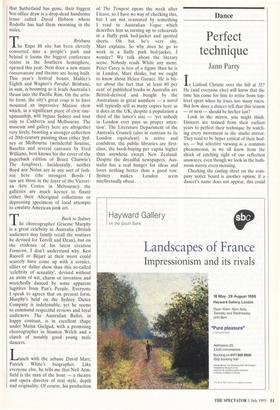Dance
Perfect technique
J ann Parry Is Linford Christie over the hill at 35? He (and everyone else) will know that the time has come for him to retire from top- level sport when he loses too many races. But how does a dancer tell that this season — or next — should be his/her last?
Look in the mirror, you might think. Dancers are trained from their earliest years to perfect their technique by watch- ing every movement in the studio mirror. They tend to be hyper critical of their bod- ies — but selective viewing is a common phenomenon, as we all know from the shock of catching sight of our reflection unawares, even though we look in the bath- room mirror every morning.
Checking the casting sheet on the com- pany notice board is another option: if a dancer's name does not appear, this could be the artistic director's heavy hint that something is wrong. Cue for a confronta- tion between dancer and management but is an artistic director entitled to say `You're too old/fat/short/incompetent . . I want you out'?
Darryl Norton, a dancer for 12 years with English National Ballet, has sued the com- pany for unfair dismissal on the grounds that he had been asked to leave for 'defects' that were not within his control: his height (5'7"), his age (34), and the fact that he was not a star performer. 'He was capable,' protested his barrister. 'He just wasn't as good as Derek Deane [ENB's artistic director] wanted him to be. This is an economic and not too unpleasant a way to bring a career to an end. But it is not fair.'
The industrial tribunal has yet to pass judgment, so no one is commenting on the rights and wrongs of Norton's case. Howev- er, his barrister's cry of 'not fair' reverber- ates through the dance profession. Performers want some kind of protection against the whims of an artistic director; meanwhile, directors claim the right to make their own choices, including the size, age and shape of the corps de ballet.
'You have to acknowledge a director's artistic authority, otherwise a company is undirectable,' says Christopher Bruce, who took charge of Rambert Dance Company in 1993. The board had sacked his prede- cessor, Richard Alston, and temporarily closed down the company, so that Bruce could start afresh with his own choice of dancers. 'The quality of a company depends on the suitability of each individu- al artist,' Bruce believes. 'Only the director can decide which people go together, and removing the misfits can be a painful pro- cedure. But the privilege of being an artist, of earning your living doing something you love doing, does not extend to having a job for life.'
Bruce points to the disastrous effect job security often has on ballet companies attached to European opera houses. There, dancers are paid salaries, like civil servants, until they choose, or are persuaded, to retire and draw their pensions. The result, according to Bruce, is that a choreographer like himself can use only 30 per cent of the dancers in the company: the rest are unable to accommodate a guest choreogra- pher's demands; some see no need to attend class or rehearsals.
Conditions are gradually changing, as opera houses everywhere face budget cuts. In Russia, the Bolshoi and Kirov have been battling to introduce a contract system; in Scandinavia, artistic directors have quit in droves because they are no longer pre- pared to endure entrenched (non) working practices. Simon Mottram is to resign from the Royal Swedish Ballet after its visit to London in July; three other Swedish com- panies have vacant director's posts; and Peter Schaufuss leaves the Royal Danish Ballet at the end of this month, one year into a seven year contract.
Doubtless, there are grievances on all sides. Incoming artistic directors, like new business directors, tend to bring in their own people and 'let go' previously valued members of the company. (I have also noticed that ballet directors frequently favour dancers who physically resemble themselves. A tall director gets rid of small dancers, a thin director ends up with an emaciated company.) The Paris Opera Bal- let guards against such predilections, and against the casting couch, by requiring per- formers who face the sack or who seek pro- motion to take an 'examen de la danse', in which their prowess is assessed by judges from outside the company.
In this country, dancers in the major, subsidised companies are protected against unfair dismissal by Equity contracts and by standard industrial legislation. Equity con- tracts define the dismissal procedure in two appendices: one deals with 'capability' meaning 'skill, aptitude, health or any other physical or mental quality'; the other covers the retirement of a dancer nearing the end of his/her career. (There is no statutory age for retirement. Margot Fonteyn carried on to the age of 60; Nureyev danced almost until his death at the age of 54.) The retirement clause is a recent one, introduced in 1990 to avoid the embarrassment of managements having to tell senior artists that they were considered 'incapable'.
None the less, retirement can be an awk- ward issue, especially when it involves per- formers still in their thirties. Fiona Chadwick, a former principal dancer with the Royal Ballet, was 34 when she was called for an interview with her artistic director, Anthony Dowell. 'I thought he was going to discuss future casting,' she says. 'I had no idea that he wanted me to retire — I was bowled over. He said that it was apparent, looking at the casting, that he wasn't going to use me, so it would be better for me to leave than to hang about doing nothing.'
She was relieved that she was not being accused of incompetence or being offered 'Sony, man, you've chosen a really bad week' remedial classes (required by the capability appendix). Thinking it over, she admits, 'I suppose they tried to handle things as well as they could, but it sent shock waves through the company, as well as through me. I made it clear that I wouldn't just fade away without a settlement, and I stayed on to the end of the season so that my fans would know I was giving my last perfor- mances.'
Fighting back through an industrial tri- bunal, as Darryl Norton has done, is fraught with difficulties and potential humiliation, which is why such cases are rare. When Geoffrey Wynne took the Lon- don Festival Ballet to court in 1983, he had to produce witnesses to testify that he was not weak or effeminate. (He won his case for unfair dismissal.) According to John Robinson, Equity organiser for ballet, dancers are advised to contest dismissal only if the procedures have not been observed or have been misapplied.
'The union accepts that an artistic direc- tor has a right to express his or her views about the dancers in a company,' Robinson says. 'But those opinions can't necessarily be put into effect as quickly as the director may wish.' In other words, if an artistic director wants to shed dancers he considers too short, chunky, old or otherwise unap- pealing, he will need to offer a settlement — which his company might find difficult to afford.
The conditions of a settlement can be a way of preventing dismissed dancers from making their objections public. When bal- lerina Marion St Clair and her husband, Michael Beare, were required to leave London City Ballet, they were told not to talk to the press and to pretend that they had resigned or retired voluntarily. Indig- nant fans rallied round, but the pain of rejection is always hard to endure. Few leading dancers are objective enough about their careers to pre-empt a management decision by quitting ahead of time.
Those lower in the ranks are often obliged to be more realistic. 'Thirty is a real milestone in a dancer's career,' says Mark Welford, who decided to retire from Birmingham Royal Ballet at the age of 35. 'The demands on your body become harder to endure, especially if you've had an injury. I didn't want to be told by an incom- ing director that I was no longer needed. I'm lucky because I've danced myself out — I don't want to do it any more.' He now runs a flower shop, with fellow ex-dancer Stephen Wicks, in Covent Garden.
Welford was a delegate to a recent inter- national symposium in Lausanne on the transition of professional dancers to anoth- er career. 'Everyone agreed that dancers should be taught from the start to prepare for a life after dancing,' Welford says. 'It's hard — I remember at the age of 11, at the Royal Ballet School, I couldn't even envis- age being 30. All I wanted was to join the Royal Ballet. Anything else would have seemed failure.' There is a support system in Britain for dancers whose careers have ended, for whatever reason. The Dancers' Resettle- ment Trust and Fund helps performers retrain for a second career and offers coun- selling even for those who don't qualify for a bursary. Welford acknowledges that dancers often need help because they have so little sense of perspective. 'When you leave a company, it's like jumping off a precipice. Then you discover there's a ledge just below that you didn't see. Then you realise it's not a ledge but a vast great plain with a whole new horizon, and you look back and see just how small your world was.'
Jann Pany is dance critic of the Observer.




































































 Previous page
Previous page